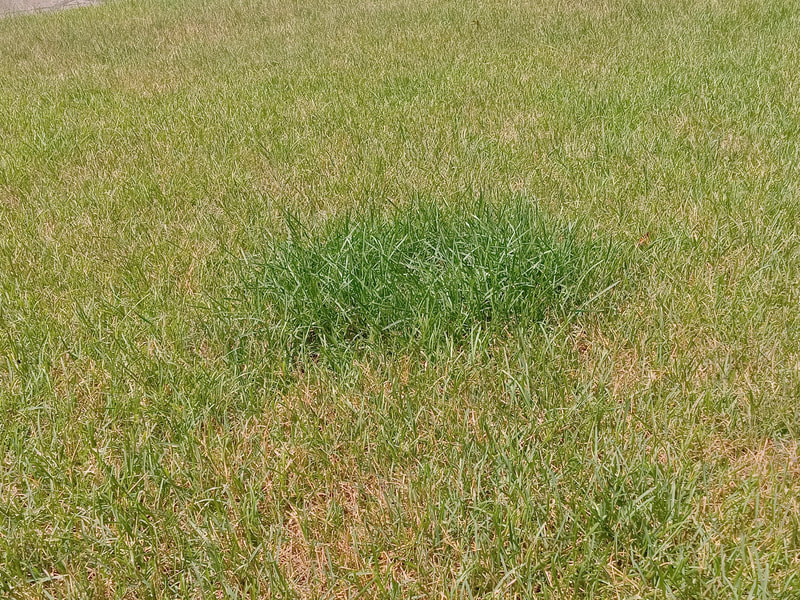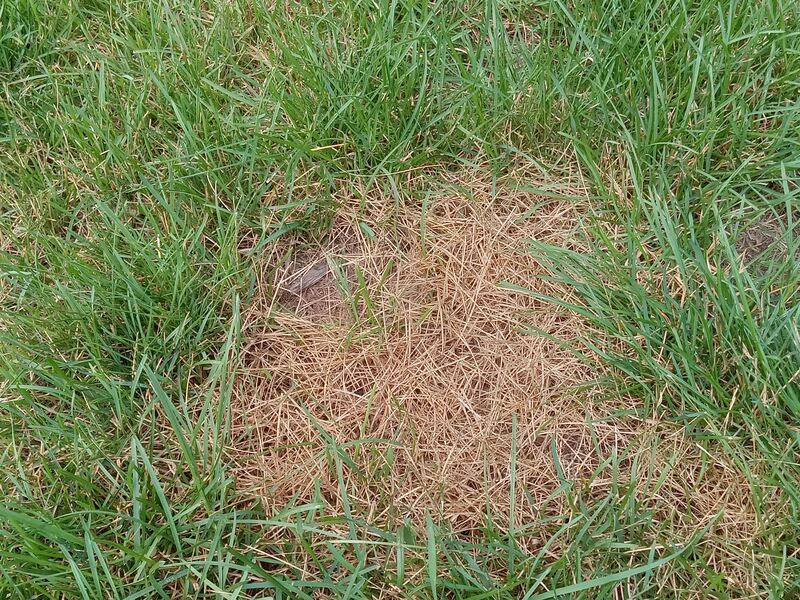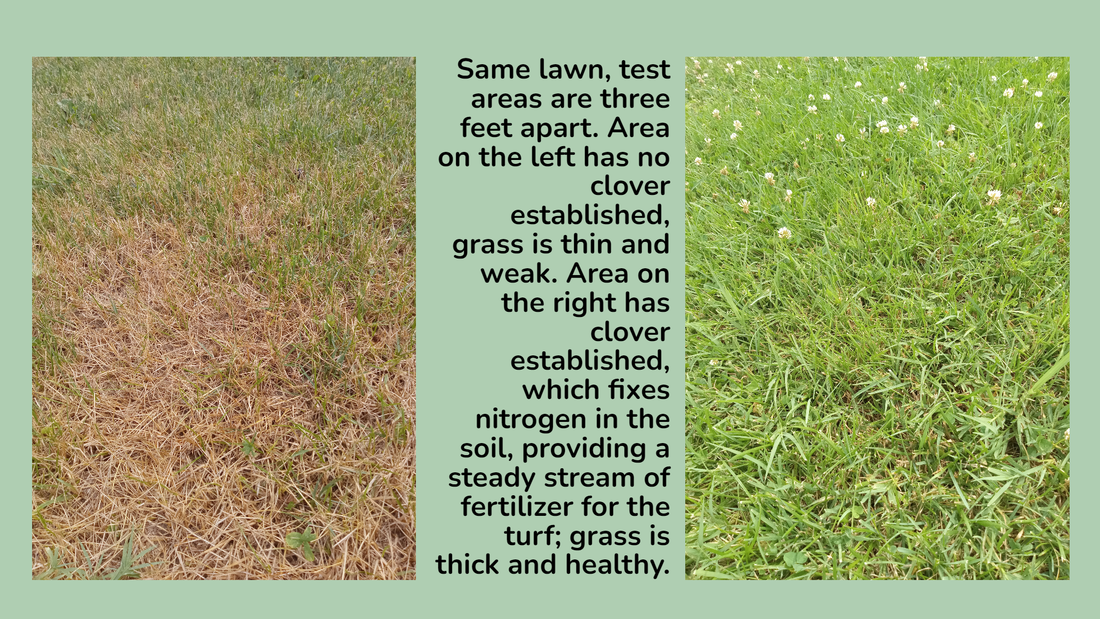Dogs love fertilizing lawns. They just don' t know when to quit. Here's what you can do to help.7/12/2022 Those of us with dogs know how hard it can be to keep the grass looking nice in the "potty area" of the yard. Female dogs especially are notoriously damaging to turf.
The question, though, is why? Female dogs, as well as some young males, senior males, and males who just never got the urge to lift their leg to pee, squat and deposit their urine directly into the turf. Males who lift their leg typically spread their pee around the yard, and actually pee on something like a tree or landscaping. So the yards where male dogs are peeing a little here and there typically don't see as much "urine burn" on the grass. But let's talk about the yards where dogs squat and pee right into the turf. A common misperception is that those urine burns come from the acidity in the dog's pee. And while urine is acidic, that's not actually what's causing the burn. It's actually nitrogen. Urine is pretty high in nitrogen, so what your dog is doing is fertilizing your grass whenever she pees. the problem is that she just doesn't know when enough is enough. With a female dog (or male dogs who squat to pee), there's a chance you've got some very lush-looking spots in your yard mixed in with some very dead-looking spots. The lush spots are where the dog's done some great work putting nitrogen into the soil. The dead spots are where she's overdone it. Either way, most of us don't want such uneven turf in our yard; we'd prefer a bit more uniformity. So what can you do about fixing this unevenness in the turf? First, don't waste your time and money on pills that claim to eliminate turf burn. They're just not effective. If anything, you could reduce the amount of protein in your dog's diet, as high-protein means higher nitrogen in the pee. That being said, there's still going to be nitrogen potentially burning your grass no matter how much you reduce the protein in her diet (and dogs do need protein, so you don't want to eliminate it altogether!). The more sustainable fix is to increase the frequency of your watering in the potty area. Normally, I suggest less-frequent but deeper waterings for your lawn, but when it comes to your dog's potty area, I suggest watering for 3-5 minutes every 1-2 days (you should also continue doing a deeper watering every 7 to 10 days). Even if you don't want to turn the sprinkler on for that short of a period, just put a spray nozzle on your hose and spray it down for a few minutes, giving a bit more attention to the specific spot where your dog recently peed. These frequent short waterings will help disperse the urine into the soil and dilute the nitrogen so you won't be facing so much unevenness or dead spots in your turf.
0 Comments
At Good Sweet Earth, we're big fans of clover in lawns (see: here & here). It fills in gaps and keeps out less attractive weeds, it stays green all summer, it's great for pollinators, it's good in high-traffic areas, but one of the best parts is that it actually puts nitrogen into the soil. It provides fertilizer naturally for your lawn. From the University of Georgia Extension: Nitrogen is "fixed" in clovers through a symbiotic relationship with Rhizobium bacteria that infects the plant's roots. The plant provides energy for the bacteria, and bacteria provide the "machinery" necessary to convert atmospheric nitrogen into a form available to plants. Nitrogen fixation is one of many economically important features of clover, particularly when clover represents a substantial proportion of available forage. A vigorous stand of white clover will fix 100-150 pounds of nitrogen per year depending on soil and growing conditions But what does nitrogen fixing actually mean for your lawn? It means that in areas where you've got clover growing, your grass will be healthier too-- greener, thicker and stronger in drought conditions. Take a look at the lawn below where Dutch white clover is currently being established. The test sample on the right, with clover currently fixing nitrogen in the soil, shows shows thicker, greener turfgrass, even during the heat of summer months.
 Overseeding your lawn is a really important part of having a thicker, healthier and greener lawn with less weeds. It really isn't difficult to do, but it does require some knowledge to get the most germination for your buck. Read on to learn the why, what, how, when and where of overseeding your lawn. Keep in mind, we're a West Michigan-based company, so our recommendations are targeted for this region. When should you overseed? The short answer: either the spring or late-summer/early-fall. Late-summer/early-fall is ideal, however. The longer explanation is that the grass that grows in Michigan is called "cool weather turf." That means it grows best in cool temps-- when daytime air temperatures are between 60 and 75 degrees. (I like to call this "open window weather," when you need neither your furnace nor air conditioner to make your house comfortable.) When temps drop below 60 for an extended period (late fall & winter), the grass goes dormant. When temps rise above 75 for an extended period (summer), the grass also goes dormant. Winter and summer are terrible times to put down grass seed in Michigan; the seeds just will not germinate. So the ideal time is to put down seed in the late-August to mid-September. This is when the nighttime temperatures start dipping into the 50s again, which will help lower the soil temp to an optimal point for seed germination. Fall is also a great time to overseed because of the life cycle of annual lawn weeds. Annual lawn weeds germinate in the spring, drop their seed in the summer, and die off in the fall. If you can put down some grass seed in late summer or early fall, it'll have time to germinate before winter. This will help fill in gaps in your lawn, so next spring when those weed seeds are looking for a place to sprout, you'll already have grass growing there. While fall is ideal for overseeding, you can also do it during the spring growing season (typically late April to late May). The competition for nutrients, water and space is just a bit more fierce in the spring. Fall and spring are also the time to pull up weeds (or, if you absolutely must, put down an herbicide). If you're removing weeds from your lawn, you're typically opening up a space on your lawn as well. Now is the time to do the overseeding, so that grass will fill that gap instead of a new weed. Something is going to grow in that gap-- let's make it grass. 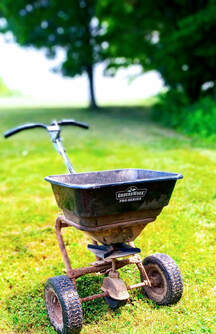 Overseeding your lawn is a really important part of having a thicker, healthier and greener lawn with less weeds. It really isn't difficult to do, but it does require some knowledge to get the most germination for your buck. Read on to learn the why, what, how, when and where of overseeding your lawn. Keep in mind, we're a West Michigan-based company, so our recommendations are targeted for this region. How should you overseed? When overseeding your whole lawn you should follow these practices: 1. Mow your lawn the day of or the day before you overseed, and set your mower a notch or two lower than you normally mow at (not the lowest or second-lowest settings; you'll scalp your lawn). You should also either bag the clippings or rake up as many clippings as you can before putting the seed down. Now both of these practices (mowing shorter and removing the clippings) go against my normal recommendations, but there's a reason for it. Mowing the grass shorter than normal allows the seed to move down to the ground easier. It also allows you to go a little longer before you need to mow again so you're not sucking up the baby seedlings. Removing the clippings from the lawn before overseeding also helps the seed work their way down to the soil easier. 2. Using a push spreader or hand spreader, apply the grass seed mix just as you would fertilizer, in even rows, in a snaking motion across your lawn. It's best to do it on a calm day, when the grass is dry. 3. Water immediately for 20-30 minutes. Then for the next 14 days, water daily for about 10-15 minutes in the morning. If it's an especially warm day (80-degrees or more), you might want to do another 10-15 minute watering in the evening. Short daily waterings aren't normally recommended for your lawn, but think about these seeds as babies-- they need constant help from you until they grow roots and can find water on their own. Until these seeds germinate and grow to about 1/2-inch tall, you need to give them water every day. The soil must remain damp for the first two weeks, or the seeds won't sprout, and if the new seedlings have sprouted, they'll whither and die. 4. After about 14-20 days, feel free to mow again. This may mean letting your lawn get a little shaggier than it normally looks, but tough it out so that your new grass has a good chance to germinate, take root and begin its new life on your lawn. Basically, go as long as you can before mowing again. But what if you've got larger patches in your lawn where grass just doesn't seem to do very well? You've tried seeding there before, only to have it not germinate or, if it does germinate, die off shortly after. Or maybe you've got areas where pets have killed the grass with their urine. This could mean you've got bad soil there. I'd recommend putting down some organic matter-- a compost/topsoil blend would be good. Even better than that, we sell a blend called Lawn Soil, which we've been using for a few years now with amazing results. It's specially formulated to help seeds germinate quickly and new grass to be thick and lush. Once you've put down some organic matter on the area, you can overseed as recommended above. 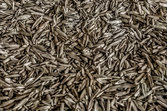 Overseeding your lawn is a really important part of having a thicker, healthier and greener lawn with less weeds. It really isn't difficult to do, but it does require some knowledge to get the most germination for your buck. Read on to learn the why, what, how, when and where of overseeding your lawn. Keep in mind, we're a West Michigan-based company, so our recommendations are targeted for this region. What type of seed should you overseed with? Simply put, you need to put down a sun/shade mix of grass seed. You can buy this type of mix in most stores. You can also buy it right on our website; this is what we've been using for our own lawn and recommending to our customers for years. Don't waste time trying to figure out if you need fescue or ryegrass or bluegrass. Just put down a sun/shade mix over your whole yard, and let nature sort it out. The shade-loving varieties will germinate in the shady areas, the sun-loving varieties will germinate in the sunny areas. I'm also a big fan of Dutch white clover, and you should be too! You could also put down some clover seed to fill in gaps where grass struggles to take hold. We sell that too. |

